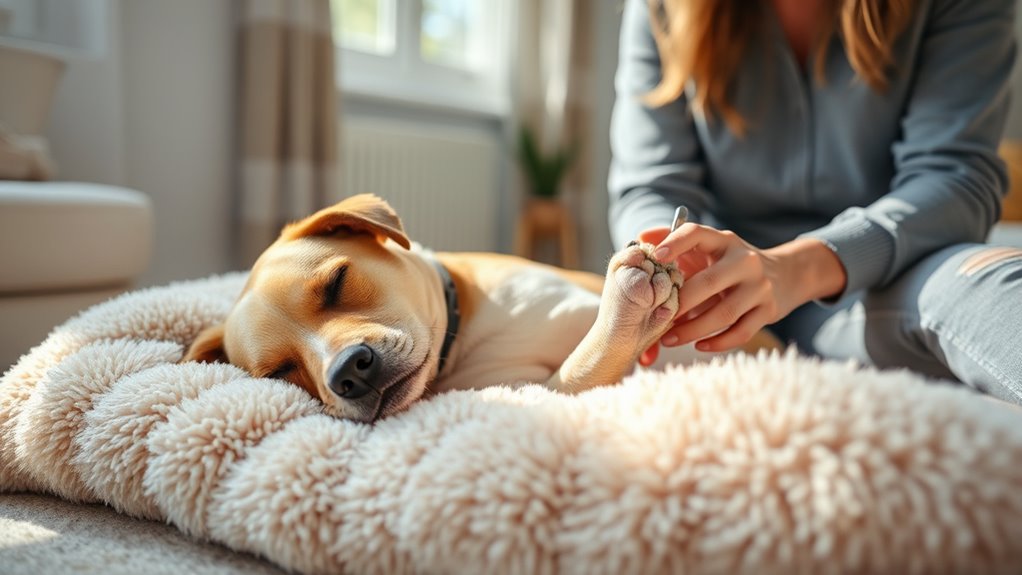To make nail trims stress-free, recognize your pet’s comfort cues and create a calm environment by using soft lights, familiar scents, and gentle sounds. Use quiet, sharp tools and handle paws softly, pairing the process with treats and praise to build trust. Follow step-by-step techniques and gradually introduce paw handling to reduce resistance. Maintaining nail health prevents future stress, and with consistent, positive approaches, nails can be trimmed comfortably—discover more ways to keep your pet relaxed throughout the process.
Key Takeaways
- Recognize early stress cues like trembling or lip licking and adjust handling to keep the pet calm.
- Use positive reinforcement such as treats and praise during nail trimming to create positive associations.
- Prepare a quiet, familiar environment with soft lighting and minimal distractions to reduce anxiety.
- Handle paws gently, starting with soft petting and gradually introducing nail contact to desensitize the pet.
- Keep tools quiet, sharp, and well-maintained, and use gentle, calm movements to promote cooperation.
Understanding Your Pet’s Comfort Cues

To keep nail trims stress-free, it’s essential to recognize your pet’s comfort cues. Pet relaxation varies, so pay close attention to their body language. Signs of stress signals include trembling, lip licking, yawning, or trying to pull away. If your pet shows these signs, it’s a clear indication they’re uncomfortable. Conversely, relaxed pets often have soft eyes, loose muscles, and a calm demeanor. Noticing these cues early helps you adjust your approach, making the experience more positive. When your pet exhibits stress signals, it’s beneficial to pause and employ calming techniques such as gentle petting or soothing voice tones before continuing. Being attuned to their comfort cues ensures you create a safer, more relaxed grooming environment. This awareness fosters trust, making future nail trims easier for both of you. Recognizing stress signals early on can prevent additional anxiety and help build positive associations with grooming. Additionally, understanding body language related to stress can guide you in timing your interventions more effectively, especially when combined with knowledge about indoor air quality and how stress may affect your pet’s overall health.
Creating a Calm Environment for Grooming
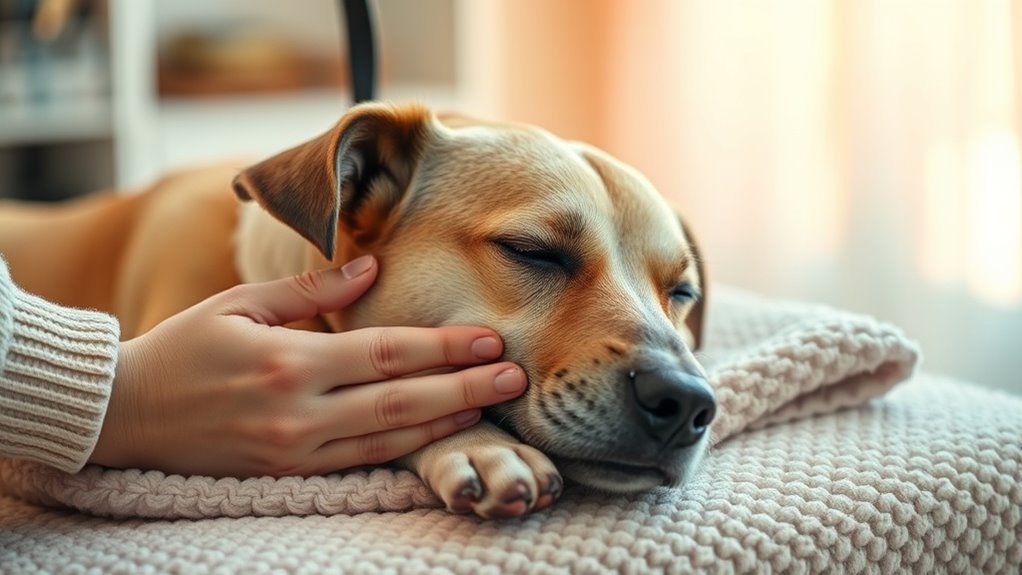
Creating a calm environment sets the tone for a stress-free grooming session. Start by arranging furniture to create a quiet, clutter-free space where your pet feels secure. Remove distractions like noisy appliances or toys that could cause anxiety. Adjust the lighting to be soft and gentle, avoiding harsh or bright lights that might startle your pet. Dim the room slightly or use natural light to foster a soothing atmosphere. Keep the environment predictable by maintaining a consistent grooming spot and routine. This familiarity helps your pet relax and reduces stress. Remember, a calm setting encourages cooperation, making nail trims smoother for both of you. Small adjustments in furniture placement and lighting can considerably impact your pet’s comfort during grooming. Incorporating calming music or soundscapes can further enhance relaxation during the process, especially when considering emotional detachment that some pets may experience during stressful situations. Additionally, understanding the importance of biodiversity in our environment can remind us that creating peaceful spaces benefits not only our pets but also supports local wildlife and ecosystems. Recognizing the role of a peaceful environment in reducing stress can help create a more positive grooming experience for your pet.
Choosing the Right Tools for Stress-Free Nail Trimming

Choosing the right tools can make nail trimming much easier and less stressful for your pet. Sharp clippers cut smoothly and quickly, reducing discomfort, while blunt ones may cause tugging or splashing. Additionally, quiet tools help keep your pet calm and prevent unnecessary anxiety during the process. Using appropriate storage for your tools ensures they stay in good condition and maintain their effectiveness. Properly maintained tools also prevent the spread of infections through hygienic practices. Incorporating calming techniques such as anti-aging effects or gentle handling can further improve the experience for both you and your pet.
Selecting the right nail clippers can make a big difference in how stress-free the trimming process feels. Sharp clippers provide clean cuts, reducing nail clipping time and discomfort, which helps ease pet anxiety. Blunt tools can crush or splinter nails, causing pain and increasing stress. To choose wisely, consider these points:
- Sharpness: Opt for well-maintained, sharp blades to ensure smooth cuts.
- Design: Look for ergonomic handles for better control and comfort.
- Material: Stainless steel blades stay sharper longer and are easier to sanitize.
- Automation and tools: Using advanced tools like electric nail grinders can further reduce stress during trimming. Incorporating proper technique and patience can also make the process more comfortable for your pet.
- Additionally, selecting tools with safety features can help prevent accidental injuries and make the experience even more stress-free.
- Modern grooming tools incorporate smart technology that can monitor nail health and provide feedback, making the grooming process safer and more effective.
Using sharp, well-designed clippers makes nail trimming quicker and less stressful, fostering a more positive experience for both you and your pet. The right tools help minimize discomfort, making nail clipping more manageable.
Quiet Tools Preference
Because loud noises can increase your pet’s anxiety during nail trims, opting for quiet tools is essential for a stress-free experience. Choosing tools designed for pet comfort helps create a calm environment. Look for nail clippers with noise-reducing features or electric files that operate quietly. The right tools can make a significant difference in reducing stress and ensuring safety. Consider this comparison:
| Tool Type | Benefits |
|---|---|
| Quiet Nail Clippers | Less noise, calmer pet during trimming |
| Electric Files | Smoother finish, less pressure needed |
Selecting quiet tools prioritizes your pet’s comfort, making nail trims easier for both of you. When your pet feels relaxed, nail trimming becomes a cooperative, stress-free experience. Additionally, understanding dog quotes for reflection and humor can help keep both you and your pet in a positive mood during grooming sessions. Proper AI-powered pet care tools are also emerging as helpful aids to monitor and ease your pet’s stress levels during grooming, aligning with advancements in AI in Business to improve overall pet care experiences. Furthermore, choosing noise-reducing grooming equipment can significantly enhance your pet’s comfort during nail trims.
Building Trust Through Positive Associations
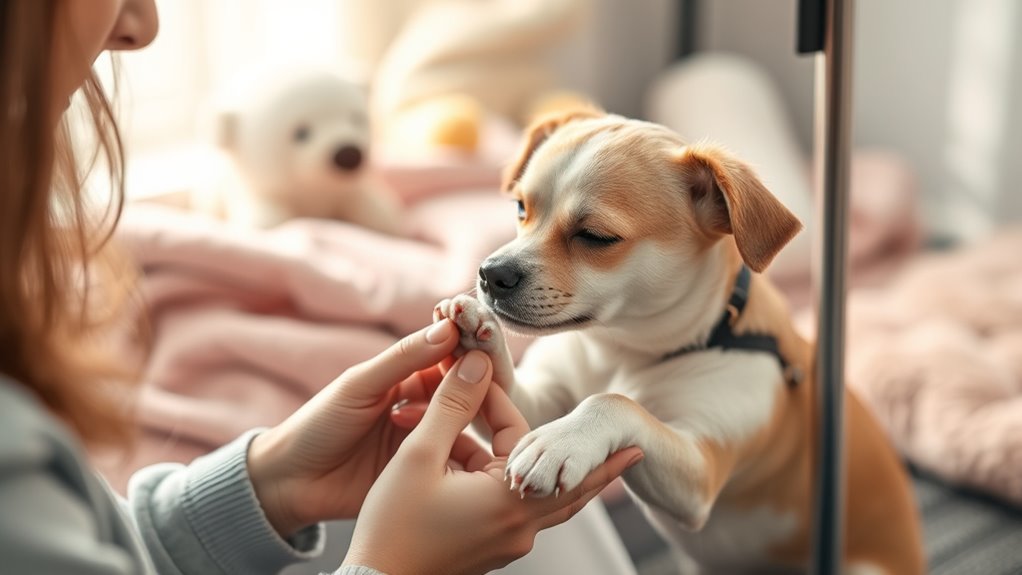
Building trust with your dog is essential for stress-free nail trims, and one effective way to do this is by creating positive associations. When you link nail trimming with pleasant experiences, your dog’s behavior improves, and pet psychology shows they become more comfortable over time. To build these associations:
- Pair nail trims with treats or praise, so your dog begins to associate the process with rewards.
- Use calm, gentle handling to help your dog feel secure and reduce anxiety.
- Keep sessions short initially, gradually increasing duration as your dog becomes more confident.
- Understanding the divorce process in Berlin can help you manage your stress and maintain a calm environment for your pet during grooming routines.
- Incorporating positive reinforcement techniques consistently can further enhance your dog’s trust and cooperation, especially when combined with desensitization exercises to gradually accustom your dog to nail trimming tools.
- Recognizing the horsepower of electric dirt bikes can motivate you to stay patient, knowing that steady progress builds trust over time.
Consistently applying these techniques fosters trust and makes nail trims a stress-free part of your routine. Your patience and understanding are key to shaping positive behavior.
Step-by-Step Techniques for Gentle Nail Trims
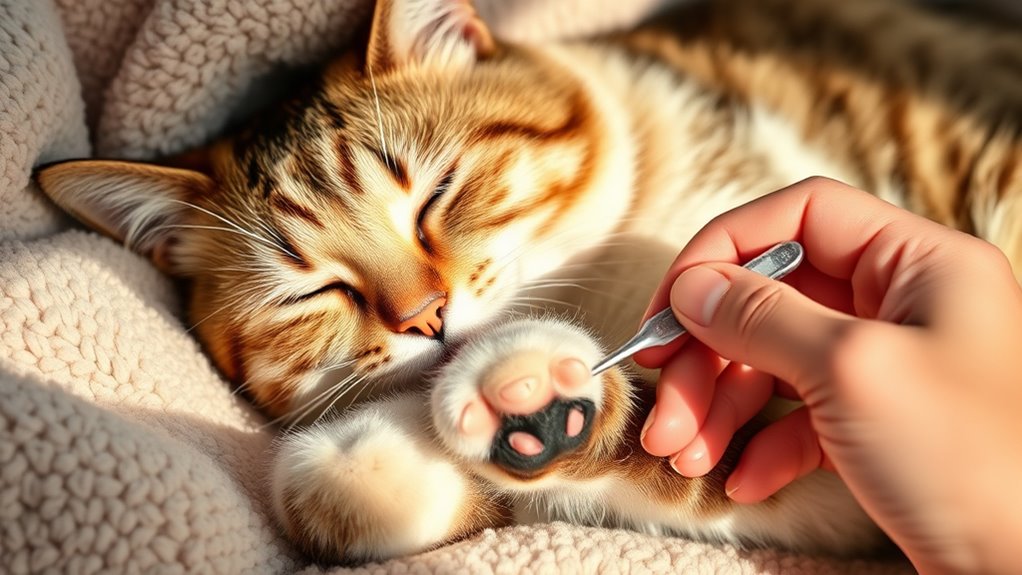
To make nail trims stress-free, start by preparing a calm environment that minimizes distractions. Use positive reinforcement to reward your pet for calm behavior, and handle their paws gently to build trust. These simple steps set the stage for a smooth, gentle trimming process. Consistent grooming routines can help your pet become more comfortable with nail trims over time. Regularly clean and maintain grooming tools to ensure safe and effective nail trims. Being aware of common senior health issues can also inform your approach and make the experience more comfortable for your pet.
Prepare the Environment
Creating a calm and safe environment is essential for a stress-free nail trim. You want your pet to feel comfortable and secure throughout the process. Start by pet scenting familiar items nearby, like a blanket or toy, to help your pet feel at ease. Minimize visual distractions around the trimming area to prevent your pet from becoming anxious or distracted. Consider setting up a quiet space where your pet can relax before the trim begins. Keep lighting soft and avoid sudden movements that might startle them. Use these strategies to create a controlled environment that promotes cooperation and reduces stress. Remember, a calm setting helps your pet associate nail trims with safety and comfort.
Use Positive Reinforcement
Using positive reinforcement is one of the most effective ways to make nail trims gentle and stress-free. When your pet shows calm behavior, immediately reward good behavior with treats, praise, or gentle petting. This encourages them to associate nail trimming with positive experiences, which can help reduce treating nail discomfort over time. If your pet remains relaxed, continue to reward their cooperation throughout the process. When they resist or become anxious, pause and give them a break, then try again later. Consistent positive reinforcement builds trust and helps your pet feel safe. Over time, they’ll start to see nail trims as a rewarding experience rather than a stressful ordeal, making future grooming sessions smoother and more comfortable for everyone involved.
Handle Paws Gently
Handling your pet’s paws gently is essential for a stress-free nail trim. A gentle touch helps your pet feel safe and reduces anxiety. Start by softly petting and massaging their paws to build trust. When ready, gently hold each paw, avoiding sudden movements. Use a calm voice to reassure your pet throughout the process. Incorporate paw massages to desensitize them and make handling easier next time. Remember, patience is key—if they resist, take a break and try again later. Consistent gentle handling encourages cooperation and minimizes stress.
- Use a gentle touch during paw handling and massage.
- Gradually increase pressure to desensitize your pet.
- Always speak softly to maintain a calm environment.
Handling Resistance and Managing Anxiety
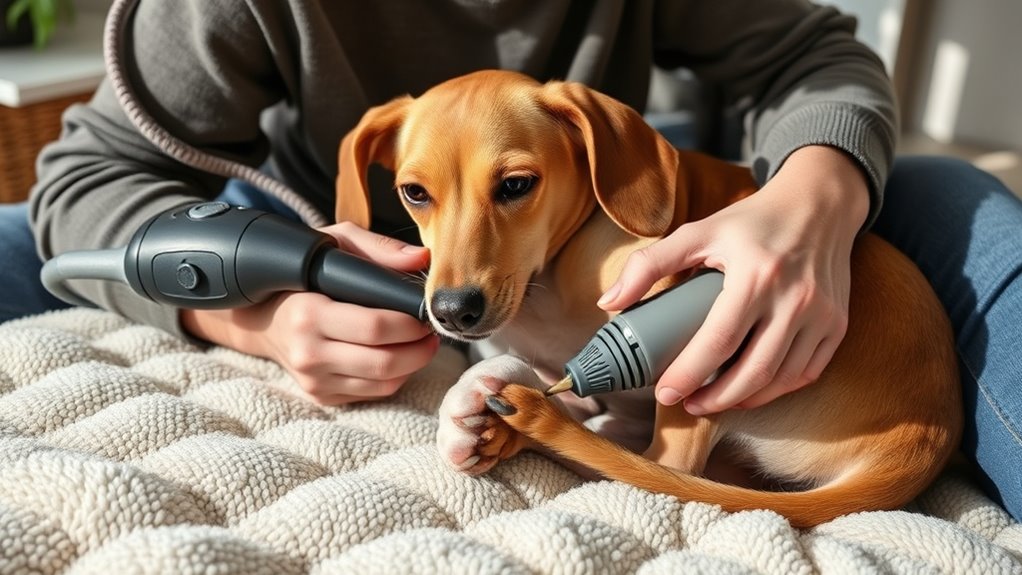
When your cat resists nail trims or shows signs of anxiety, addressing their behavior calmly and confidently can make a big difference. Start with behavior modification by giving gentle praise and treats when they remain calm. Use desensitization techniques to gradually introduce your cat to handling their paws and the trimming process. Begin by touching their paws during relaxed moments, then slowly progress to holding their paws longer. Keep sessions short and positive, respecting their comfort level. If your cat becomes anxious or resistant, pause and give them space to relax before trying again. Consistency is key; over time, these strategies help your cat associate nail trims with positive experiences, reducing resistance and anxiety. Patience and gentle handling build trust and ease the process.
Maintaining Nail Health and Preventing Future Stress
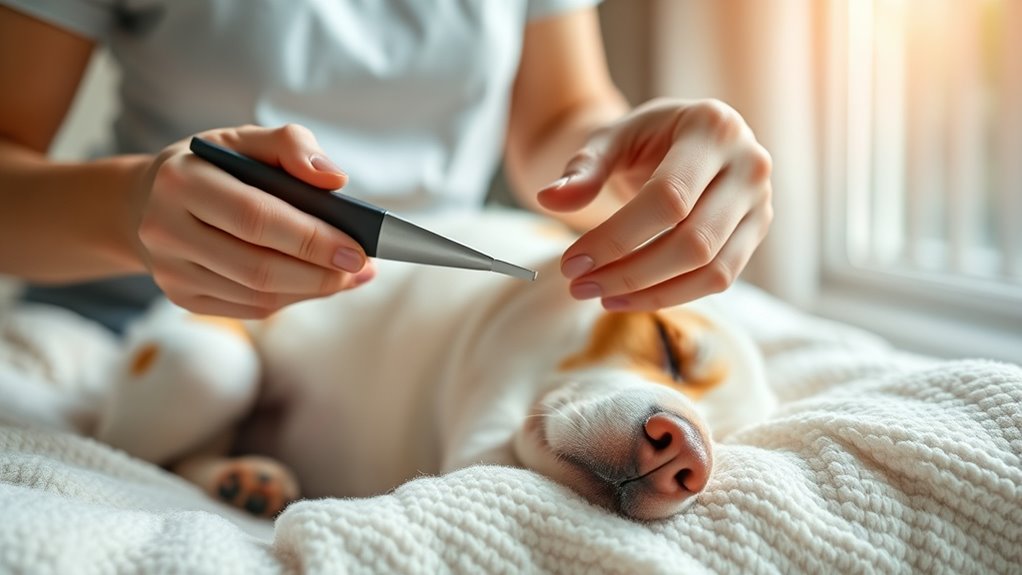
Keeping your cat’s nails healthy not only reduces the need for frequent trims but also minimizes stress during grooming sessions. To maintain nail health and prevent future stress, focus on understanding nail bed anatomy and watching for signs of nail fungus. Healthy nails have a strong, smooth surface and normal color, which indicate good nail bed health. Regularly check your cat’s nails for any abnormalities or signs of infection. Here are three ways to promote nail health:
- Provide appropriate scratching posts to naturally wear down nails and protect the nail bed.
- Keep nails clean and dry to prevent nail fungus and infections.
- Schedule regular, gentle trims to avoid overgrowth, reducing the risk of stress and injury.
These practices help keep nails healthy and make future grooming sessions less stressful.
Frequently Asked Questions
How Long Does It Typically Take for a Pet to Become Comfortable With Nail Trims?
You might wonder how long it takes for your pet to become comfortable with nail trims. Desensitization timelines vary, but with patience strategies, you could see progress in a few sessions, often within a week or two. Consistent gentle handling, positive reinforcement, and gradual exposure help your pet feel safe. Remember, every pet is unique, so stay patient, and don’t rush the process for the best results.
Can Certain Breeds or Ages Require Different Grooming Approaches?
Different breeds and ages do require tailored grooming approaches. Breed-specific grooming considers coat type, hair length, and typical grooming needs, making trims easier and more comfortable. Age-related care adjusts for your pet’s mobility and sensitivity, especially with seniors or puppies. By understanding these differences, you can provide more effective, stress-free grooming sessions, ensuring your pet stays healthy and relaxed during nail trims and other grooming tasks.
What Signs Indicate My Pet Might Have a Nail or Paw Injury?
Your pet’s paw is like a delicate garden needing care. If you notice paw swelling or limping, it’s a sign something’s wrong, like a storm brewing beneath the surface. Watch for signs such as licking, tenderness, or reluctance to walk. These clues help you catch injuries early, preventing further pain. Always consult your veterinarian if you suspect a paw or nail injury—quick action can be the sunshine your pet needs.
Are There Specific Treats or Rewards That Work Best for Positive Reinforcement?
When choosing treats or rewards, focus on treat selection that your pet finds irresistible, like small pieces of cheese or special treats. Timing is key—offer the reward immediately after good behavior to reinforce it effectively. You should observe your pet’s preferences and adjust accordingly. Consistently using the right treat selection and proper reward timing helps your pet associate positive experiences with nail trims, making the process easier and stress-free.
How Do I Handle a Pet That Completely Refuses Nail Trimming?
When faced with a pet that refuses nail trimming, remember that patience is your greatest tool. Think of behavior modification as planting seeds—gradually, with positive reinforcement, progress blooms. If traditional methods fail, try alternative trimming techniques like using a grinder or trimming while your pet is relaxed. Stay calm, keep sessions short, and focus on building trust. With consistency, your pet will learn to accept nail trims without stress.
Conclusion
By understanding your pet’s cues and creating a calm, trusting environment, you can turn nail trims into a stress-free experience—like a gentle breeze on a warm day. Using the right tools and positive reinforcement helps your furry friend feel safe and secure. With patience and practice, nail trimming becomes a bonding moment rather than a battle. Remember, every small step builds a foundation of trust, making grooming easier and more enjoyable for both of you.

